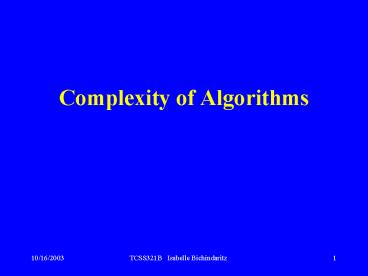Complexity of Algorithms - PowerPoint PPT Presentation
1 / 17
Title:
Complexity of Algorithms
Description:
Summing Execution Time. When summing execution times, the dominant function is the ... Summing Execution Time. When Adding Figures, Larger Eventually Dominates ... – PowerPoint PPT presentation
Number of Views:37
Avg rating:3.0/5.0
Title: Complexity of Algorithms
1
Complexity of Algorithms
2
Learning Objectives
- Understand what is complexity of algorithms.
- Practice how to calculate complexity of
algorithms.
3
Complexity of Algorithms
- Time Complexity Determine the approximate number
of operations required to solve a problem of size
n (number of comparisons, or number of basic
operations, such as addition, multiplication, ) - Space Complexity Determine the approximate
memory required to solve a problem of size n. - Time Complexity
- - Use the Big-O notation
- - Ignore house keeping
- - Count the expensive operations only
4
Complexity of Algorithms
- Basic operations
- searching algorithms - key comparisons
- sorting algorithms - list component comparisons
- numerical algorithms - floating point ops.
(flops) -multiplications/divisions and/or
additions/subtractions - Worst Case maximum number of operations
- Average Case mean number of operations assuming
an input probability distribution - Best Case minimum number of operations
5
Complexity of Algorithms
- Example maximum elementuse number of
comparisons - 1 comparison end of list 1 comparison with max
- so 2 comparisons at every iteration
- at the end of list one last comparison
- number of iterations from 2 to n gives (n-1)
iterations - total number of comparisons 2(n-1) 1
- O(n) (Worst case average case)
- O(1) (Best case)
6
Complexity of Algorithms
- Examples
- Multiply an n x n matrix A by a scalar c to
produce the matrix B - procedure (n, c, A, B integers)
- for i 1 to n do
- for j 1 to n do
- B(i, j) cA(i, j)
- end do
- end do
- Analysis (worst case, average case, best case)
- Count the number of floating point
multiplications. - n 2 elements requires n 2 multiplications. time
complexity is - O(n 2 ) or quadratic complexity.
7
Complexity of Algorithms
- Bubble sort L is a list of elements to be
sorted. - - We assume nothing about the initial order
- - The list is in ascending order upon
completion. - Analysis (worst case)
- Count the number of list comparisons required.
- Method If the jth element of L is larger than
the (j 1)st, swap them. - Note this is not an efficient implementation of
the algorithm
8
Complexity of Algorithms
9
Complexity of Algorithms
- Bubble the largest element to the 'top' by
starting at the bottom - swap elements until the
largest in the top position. Bubble the second
largest to the position below the top.Continue
until the list is sorted. - n-1 comparison on the first pass
- n-2 comparisons on the second pass
- 1 comparison on the last pass
- Total (n - 1) (n - 2) . . . . 1 n
(n-1) / 2 O(n 2 ) (quadratic complexity) - (what is the leading coefficient?)
- The total algorithm (outer and inner loops) is
in O(n2).
10
Complexity of Algorithms
- An algorithm to determine if a function f from A
to B is an injection - Input a table with two columns
- - Left column contains the elements of A.
- - Right column contains the images of the
elements in the left column. - Analysis (worst case)
- Count comparisons of elements of B.
- Recall that two elements of column 1 cannot have
the same images in column 2.
11
Complexity of Algorithms
- One solution
- Sort the right column
- Worst case complexity (using Bubble sort)
- O(n 2 )
- Compare adjacent elements to see if they agree
- Worst case complexity
- O(n)
- Total
- O(n 2 ) O(n) O(n 2 )
12
Algorithmic Analysis
- Better Characterizations using Less Information
- Question Why are dictionaries ordered?
- Answer So we can use a more efficient algorithm
to look up words. - Why is it more efficient? To search an unordered
list of n words takes, worst case, n comparisons.
To search an ordered list requires, worst case,
log n comparisons (using binary search, as we do
with dictionaries). - Note that we ignore features such as how long it
actually takes to do a comparison, as the exact
figure is relatively unimportant.
13
Algorithmic Analysis
- Asymptotic Execution Time
- Suppose f(n) is a formula that describes the
exact execution time of some algorithm for inputs
of size n. - We then determine whether f(n) is Big-O of a
well-known function. - Searching a dictionary is O(log n), for example,
while searching an unordered list is O(n). - This chapter is devoted to showing how to
characterize the asymptotic execution time
behavior of algorithms.
14
Summing Execution Time
- When summing execution times, the dominant
function is the only important one. - procedure makeIdentityMatrix (mnn matrix,
n integer) - for i0 to n-1 do
- for j 0 to n-1 do
- mi,j 0.0
- end do
- end do
- for i 0 to n-1 do mi,i 1.0 end
do - m is the identity matrix
O(n2)
15
Ranking of Execution Time
16
Summing Execution Time
- Comparison of execution times
17
Summing Execution Time
- When Adding Figures, Larger Eventually Dominates































